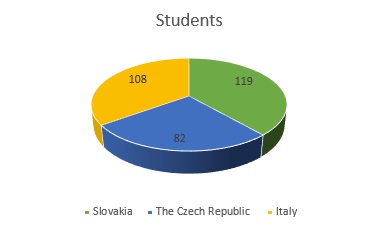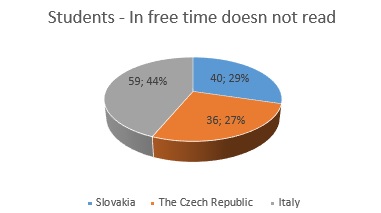
This project promotes open access materials and has been funded with support from the European Commission - Erasmus+ program. These materials reflect the views only of the author, and the Commission cannot be held responsible for any use which may be made of the information contained therein.
[Project Number: 2016-1-HR01-KA201-022159]
![]()
Partners conducted research by reviewing the state of the art in literature in order to establish the current situation, methods, objectives, policies and strategies carried out in each partner country when it comes to literacy issues and reading for targeted population of reluctant, struggling and poor readers. After doing research, partners produced critical review including contemporary journal published case studies, reports, expert article, scientific articles and discussions, presentations at professional conferences and congresses from educational Agencies and relevant Educational Institutions within country context, in order to determine existing situation.
CROATIA
In the context of education, three literacy: reading, science and mathematics stand in the center of PISA research interests. The cycle of PISA 2015 was the sixth cycle of research and for the fourth time involving Republic of Croatia encompassing 5809 15-year-old respondents. In the field of reading literacy, the Republic of Croatia achieved below the average score of 487 points (31st place). By comparing the average results from reading literacy with the results of PISA 2009 cycle in Croatia, the trend of improvement of average results is noticed. In the six-year period, Croatia has increased the average score by 11 points.
In the PIRLS Survey, evaluating readership competences for ten years, Croatia participated in 2011. The results of Croatian students are significantly better than the results achieved in PISA research. But when it comes to reading, Croatia is in the foreground. In Croatia, only 17% of students love to read, 53% like it somehow, and 29% do not like reading. Of the 57 surveyed countries, Croatia has the largest percentage of children who do not like to read.
The relation of young people towards reading is largely determined by their school-based reading experiences. Unfortunatelly, school institutions of today does not perceive them as " “digital natives” (Prensky, 2001) growing up in the world of digital media where the image (rather than the word) often contains the basic meaning and is its frequent transferee.
In order to mediate the reading of all students aged 15-18 in Croatian schools, a mandatory corpus of literary texts is selected according to the criterion of importance and value within history of European (World) and National literature. This was determined in the mid-90s of the last century. The selected corpus of literary works by their contemporariness ends in the 1990s. For a large number of students, especially those who have defined themselves as RSP readers, these texts represent a serious problem with regard to their complexity. Reception of the texts is expected from all of the students during school interpretation and analysis. The problem begins allready at the level of basic understanding during independent reading, after which pupils are expected to collect and structure the information about text with regard to literary theory and history of literature.
The Government of the Republic of Croatia adopted the National Strategy for Reading (2015 - 2020) by following the proposal of the Ministry of Culture of the Republic of Croatia, with the aim of updating the problems and unification of various factors in society that deal with reading problems in one way or another.
In addition to the shorter programmes of teacher education at the level of individual counties, The Education and Teacher Training Agency organized IV. a symposium of teachers and teachers of Croatian language who was entirely dedicated to the reading entitled "Reading for School and Life".
Based on available information on reading promotion programs, it can be concluded that a large number of programs related to the promotion of reading are offered and implemented in Croatia. Motivated teachers and students who, in most cases have good developed reading skills and higher or high motivation to read are participating these programmes.
Unfortunately, the students we describe as reluctant, struggling and poor readers often remain outside those programmes.
SLOVAKIA
According to the PISA 2015 study Slovakia achieved 453 points in reading literacy; the average of the OECD countries was 493 points. As in all previous cycles, even in PISA 2015, the performance of Slovak pupils in reading literacy is below the average of the OECD participating countries. Compared to 2012, our pupils' average performance dropped by 10, which is not a significant change. There is a comparable number of our students in the PISA 2015 risk group (32.1%) to the 2012 cycle (28.2%). These pupils do not have even the most basic reading skills necessary for further education. Most pupils in the risk group are located in secondary vocational schools and elementary schools. Even in 4-year grammar schools, the proportion of pupils in the risk group has increased statistically significantly compared to the both previous cycles (2012 and 2009). There are great gender differences in reading literacy. Girls performed statistically better also in 2015 study, on average it was 27 points higher than boys in OECD countries. In Slovakia girls scored 36 points higher. In the 2003 and 2012 cycles the difference was roughly the same but in the last cycle it decreased by 11 points. As the difference narrows, we can see gradually growing score in boys´ performance and lower performance of girls. In Slovakia the performance of girls fell by 12 points compared to the previous cycles.
According to the study conducted by State school inspection in Slovakia up to 71,3% secondary schools have no strategy for development of reading literacy although according to the principles and objectives of secondary education, systematic work with texts is part of education in Slovakia. The same study emphasizes the importance of education of teachers. Education related to the reading literacy which is the important competence in understanding all subjects across the national curriculum. Another fact the study points out is that one of the main conditions for developing reading literacy is a book and an appropriate library. However, results show that almost half of the schools do not have suitable premises for a library and almost 24,09% of schools do not have a library at all.
ITALY
In compliance with the goals of Europe 2020 strategy, the Italian government has approved a reform on our educational system in order to shape and develop common European core skills in education and training: teachers should promote the acquisition of "key competences" that the European citizen should possess to meet the challenges of the everchanging and complex world that surrounds us, for example by addressing underachievement in maths, science and literacy through effective and innovative teaching and assessment. Therefore, our school, Liceo Scientifico "G. Seguenza", has carried out an analysis which has revealed a growing need for innovative teaching strategies in the field of languages, specifically, reading skills are to be prioritised. At the end of the year 2015, the Italian National Institute of statics ISTAT published the annual results provided by the survey conducted among the Italian population about their reading habits. People aged 6 and over were interviewed and 42% of them (about 24 million) stated that they had read at least one book in the 12 months preceding the interview for purposes other than school or work. Compared to the previous year, the percentage is stable, also considering the 2011 drop in reading habits. 9.1% of the Italian households do not own any books, 64.4% have 100 books at most. Gender differences are still evident: women read more than men, indeed, the figure for female readers was in fact 48.6%, compared to 35% for male readers. Book readers' share is over 50% among those aged 11 to 19; it shows a decrease in later age groups; the highest percentage of readers was found among the 15-17 age group. School is not enough. Family is a key factor: 66.8% of youngsters aged 6 to 14 with both parents who read books are book readers too, vs. only 30.9% of those whose parents do not read books. Book reading is less widespread in the South of Italy, where fewer than one out of three (28.8%) people has read at least one book. In Sicilia and Sardegna, readers are 33.1%: an increase as compared to 31.1% recorded in the previous year. In metropolitan centres book readers account for 51%, vs. 38.1% in areas with fewer than 2,000 inhabitants. Data confirm that nearly one reader out of two (45.5%) is a "weak" one, having read no more than three books in one year. The percentage of bookworms (people who read on average at least one book per month) is 13.7% of the readers (they were 14.3% in 2014). 8.2% of the total population (4.5 million) read or downloaded books or e:books, that is, 14.1% of those who surfed the Internet. Book reading and cultural participation are interrelated: among book readers, shares of those who practise other cultural activities and sports and surf the web are regularly higher than those of non-readers. Book readers also showed higher levels of satisfaction for their leisure time (71% vs. 64% of non-readers) and their economic situation (56% vs. 42%). Between 2011 and 2012, 37.8% of the foreign citizens living in Italy report they read at least one book. In 2014, Italian households spent 3,339 million euros for books and 5,278 for newspapers, printed matter and stationery: 11 and 18 euros per month, respectively, 0.4% and 0.6% of their total expenditure for final consumption. Between 2010 and 2014, household expenditure for books, newspapers and magazines decreased by 18%, that for stationery by 31%. That reduction is much higher than the one recorded by the expenditure for goods and services as a whole (6%).
CZECH REPUBLIC
According to the Czech Ministry of Education, reading literacy should be developed not only by teachers of Czech language and literature but it should be done within most of the subjects. All teachers need to use different sorts of texts for the purpose of teaching their subjects and students should be able to work with those texts – find relevant sources of information, read it, understand, find important information, compare, interpret the information, discuss the issue etc. Today, there are also loads of different sources and types of texts available – e.g. books, magazines, newspapers, school books, e-books, the internet etc. Students should be able to sort out the information coming from all the sides, work with the resources – compare and choose the most relevant information. The experts actually agree on the basic and simple approach which should be followed to make literature more attractive to pupils. We should stop ordering them to read books hundred years old far away from their interest and everyday life. It would be much easier to begin with books or stories they really like and, in the first place, make some space for analysing and discussing the texts. It is not necessary to work with books only; especially at the beginning with struggling or poor readers, we could use films, internet articles or even PC games as sources for analyses and discussions in the class. As we can read opinions of some teachers – it is possible to go this way and there are visible fruits of this work. The most important thing the teacher needs to start is the will to change something and to work hard especially at the beginning.
What we should also do is not to force pupils read more and more; instead, we should teach them how to like and enjoy reading; after that, they will be able to find the way themselves. Schools should serve as a kind of meeting point of literature with an ability to offer different sorts of interesting texts, providing a platform for discussion including experience and opinion exchange.
• Czech students regularly score lower than the average in PISA tests.
• Czech educational framework gives schools and teachers a chance to build up their own school educational programmes and approaches towards individual subjects; reading literacy is essential to gain the required key competencies and fulfil the expected outputs.
• Most teachers still follow the old chronological model of teaching literature – they start from the very beginning, spend a long time with the ancient literature, slowly move through every single century.
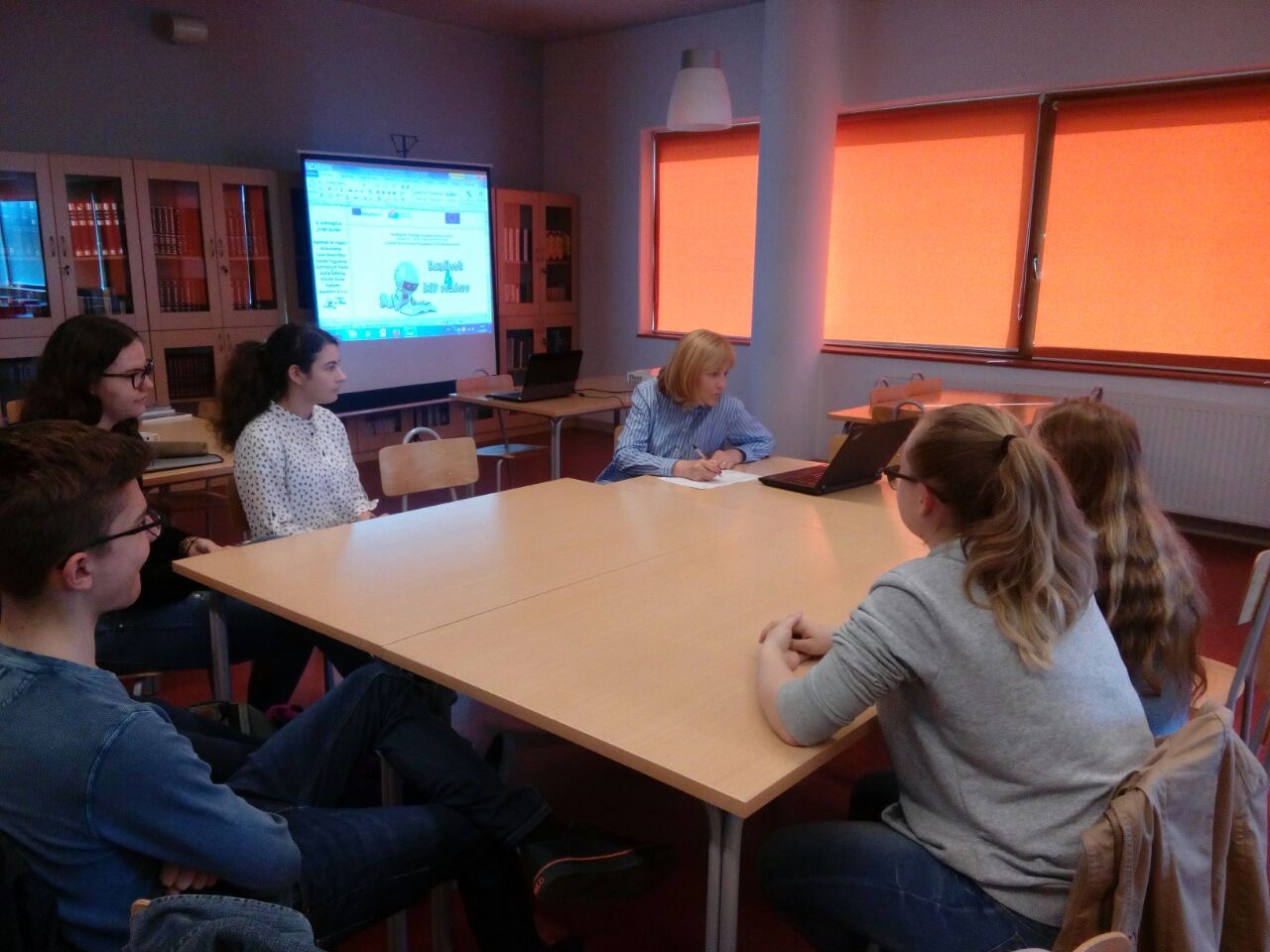
- Conduct research in field of specified activities and teaching methods
- Read numerous articles, initiatives, research in order to gather information
- Visit schools in area and country, meet target groups
- Acquire, concentrate and summarize information from the field work
You can find their report below!
Read more: Research report in the field of motivational activities
Second major project activity aimed at finding 51 engaging stories published either in national language or in English. Texts were selected by students, with a little help from the project teachers. They cover a large range, from contemporary to traditional literature and cultivate variety of themes, like teenagers’ issues, problems of young people growing up in different societies and cultures, science fiction and fantasy themes, multiculturalism, inclusiveness, migrant situation etc.
Teachers then developed methodologies to make the stories attractive to all students, regardless of their reading skills, and to make the stories easily incorporated in every class. Teachers were guided by the content development criteria and were taking reading obstacles of RSP readers into consideration at every point of the methodology development.
The following stories list provides bibliographic and all relevant surrounding information (contextual, historical etc.), the associated methodologies and a pdf document for an easy download and use during your class activities.
One of the goals of the Project Manual for reluctant, struggling and poor readers consisted of making materials for working with RSP readers. The material, named methodology in the project documentation, consists of selected text, teacher activities and activities for students, for 90 minutes. Four project partners chose one methodology that they had prepared so far. According to the pre-arranged plan, partner schools in the project: X. Ivan Supek High School (Croatia), Gymnasium Pavla Jozef Šafarika(Slovakia), Nahroni High School (Czech Republic) and Liceo scientifico Giuseppe Seguenza (Italy) conducted data collection with two questionnaires, Initial questionnaire - Questionnaire 1 and then, after each partner implemented other countries’ methodology, another questionnaire - Questionnaire 2. That is, each country collected three separate data on each of the three partner countries’ methodology offered. The methodology developed by each of the partner schools was to be carried out in their country, with another group of students who did not participate in project activities. The procedure was the same, implementation of Questionnaire 1, implementation of 90-minute activities, and then Questionnaire 2.
Questionnaire 1 consisted of 12 questions, the first four were general questions about school (country), gender and age and whether national language is the mother tongue for all pupils. There were 4 closed-type questions related to reading out-of-school habits, and the last 4 closed-type questions referred to reading within school obligations, 2 reading questions in the national language, and 2 reading questions in the English language.
Croatia
According to the data obtained in the initial questionnaire, out of a total of 115 students, 65 responded that they did not read in free time. Out of them 65, 36 students would read, but they don’t have time time, 13 would read, but do not know what, 15 students answered that they see it as a waste of time, and 1 student selected the answer that reading was not important and that nowadays it is not necessary.
30% of Croatian students see additional incentive or stimulation in having more free time, and 37% in less school obligations at home. 27% of them would like to get a recommendation for reading (interesting text). The desire to participate in conversation with their peers about what they read was chosen by 4% of students, and only 2% of them answered they needed a quiet corner in their living space.
10% and 57% of Croatian students never or rarely read the texts that are being taught in the Croatian language lessons either in school or at home, and 62% of them think that the texts are mostly not interesting. 16% of them, even without additional reading of the texts being taught, fulfill their school obligations and achieve the success they are satisfied with. 13% never or rarely read out of the classroom due to their out-of-school obligations. 19% of them do not read, because the texts are difficult and incomprehensible.
14% and 53% of Croatian students never and rarely read the texts being taught in the English language lessons outside school. 35% do not do it because the texts are not interesting, and the same percentage of students, even without additional reading of the texts being taught, fulfill their school obligations and achieve the success they are satisfied with.
In partner schools, the situation is as follows:
|
|
|
The largest number of students answered that they would read, but they don’t have time: 23 (Slovakia), 20 (the Czech Republic) and 36 (Italy).
6% and 35% of the students never or rarely reads texts that are taught in the mother tongue in the Slovakian sample outside the of the students classroom (at school and at home), and the largest percentage does not do so because the texts are not interesting (53%). Answers never and rarely for the texts in the English language were selected by 32% of the students and the reason for this is again the factor of a text being interesting to them (35%).
In the Czech sample, 13% and 56% of the students never or rarely reads never or rarely reads texts being taught on lessons of mother tongue outside regular lessons (either at school or at home) and here, the biggest percentage does not do it because the texts are not interesting (61%) . 60% of the students never or rarely read the texts that are taught in English language classes, and 22% of them, because the texts are difficult and incomprehensible and for 27% of them because the texts are unattractive.
In the Italian sample we find the highest percentage of students who read regularly (48%) and often (32%) read the texts that are being taught in the lessons of the mother tongue. But also among the 20% of those who never or rarely read these texts outside the classroom (25% think the texts are not interesting).
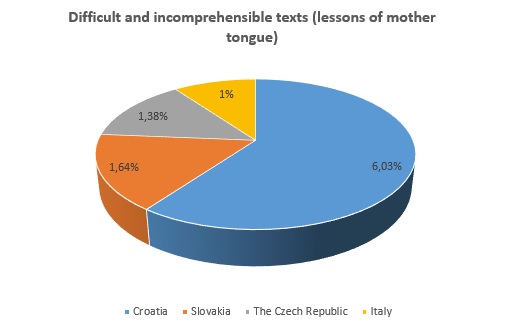

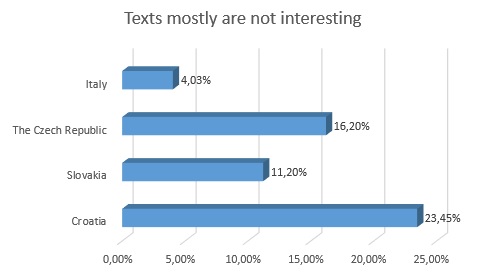

Selected partner countries’ methodologies (text, activities for teachers and student activities) for 90 minutes were conducted with students in each country. After working with the students, according to each partner’s methodology, students filled out Questionnaire 2, so students answered the same questions after each methodology.
All partners conducted their methodology with another group of students in their country.
Therefore, students' responses - shown in the tables - can be traced:
a) at the level of the offered methodology – students' answers in other countries and answers of groups of students in their own country
b) at the level of response of all students to the same questions after each of the conducted methodologies.
The questions related to how students felt during their activities in relation to the usual way of teaching - whether they were less or more interested than during the usual lessons of the subject.
Since the students were given texts that are not included in the curriculum, students compared the content of the offered text with the contents of the texts they are usually exposed to during their education - the text is similar to or is different from the majority of the texts they read; the content of the text encouraged them to think about the topic; motivated them to read the text from which the extract was taken in full or to read some other text on the same or similar subject; the text left them indifferent with their content or would like to read more texts of this content.
In the table of answers received for all selected methodologies, most students stated that the offered texts differed from those they were usually taught, but the number of students encouraged to read the text in full or some text on that subject and those that were not encouraged (A methodology text - 69:92, B methodology text - 91:75, methodology C text - 72: 102, D methodology text - 56: 109) is more or less balanced.
Keeping in mind the interaction between teachers and students during the teaching process, the offered teacher's activities in selected methodologies and self-assessment of personal involvement during each of the selected methodologies have been assessed by the students in the following two questions.
At very high percentages, it is estimated that work during the implementation of all methodologies was different, in a part of the lesson or most of the lesson. For methodology A (Croatia), 88% of Czech students, 94% of Slovak students, 53% of Italian students, 98% of Croatian students reported this. The B methodology (Slovakia) was estimated by all Croatian students as different, and then with a high percentage of Slovak students - 95% of them. A higher percentage of Czech students, 74%, and Italian students, 60%, assessed the work within this methodology as different. Students assessed the C methodology (Czech Republic) methodology as different, 83% of Italian students, 88% of Slovak students and 100% of Croatian and Czech students. A different way of work during the implementation of methodology D (Italy) was estimated by 70% of Czech students, 80% of Slovak students, 90% of Croatian students and 100% of Italian students.

It can be concluded that the highest percentage of Croatian students estimated work during the implementation of all methodologies different from the usual way of working.
In self-assessment of their own activities during the implementation of selected methodologies, it can be seen that the lowest percentage of students in all groups and within the implementation of all the methodologies, that their activity was estimated to be smaller than usual, neither text nor way of work stimulated to be more active.
The methodologies offered in relation to self-assessment of student activity during their implementation:

Croatian students have self-assessed the highest percentage of their greater activity within methodology C, the self-assessment of the greater activity of Slovak students is within the three methodologies above 50%, Czech students have noticed their greater activity within the methodology of their country, as opposed to Italian students who estimate their higher activity within their country's methodology, and within the other three partner countries' methodologies below 30%.
Task data for students was also collected, along with the text suggested within each methodology. Students could evaluate assignments within three categories. Tasks offered within methodology A (Croatia) were more interesting and encouraging to the largest number of Slovak students, 89% of them. 66% of them have self-estimated their activity greater than usual within this methodology. The highest percentage of Italian students, 68% of them estimated their activity as usual; 9% among them estimated tasks to be difficult and incomprehensible.
Tasks within Methodology B (Slovakia) are more interesting and stimulating to 86% of Slovak students. Of the students in partner countries, the highest percentage (74%) of Croatian students evaluated it to be more interesting and more stimulating. And within this methodology, the highest percentage of students whose find it difficult and incomprehensible were Italian students, 11% of them.
Croatian students, 89% of them, and Slovak students, 74% assessed the tasks within methodology C (Czech Republic) more interesting and stimulating. None of the Slovak, Croatian and Czech students in this methodology evaluated them as difficult and incomprehensible, unlike 13% of Italian students who find them difficult.
Tasks within Methodology D (Italy) are estimated as more interesting and more stimulating among the Italian students - 85% of them 33. Unlike the difficult and incomprehensible tasks within the first three methodologies, Italian students did not find tasks within this methodology as difficult and incomprehensible. In the largest percentage, 65% of Czech students evaluated tasks within this methodology to be more interesting and more motivating.
 |
 |
 |
 |
The last question was to gather information on how much the students who participated wanted more teaching hours similar to demonstrated 90-minute materials and activities in the lessons of mother tongue:

and English as a foreign language

Subcategories
Contact
X gimnazija ''Ivan Supek''
Ul. Vjekoslava Klaića 7
10000
Zagreb
E-mail: partners@handbook4rspreaders.org
